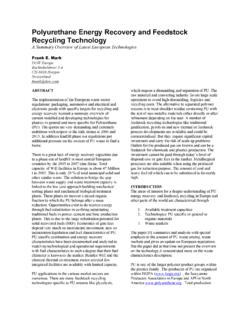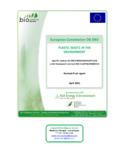Transcription of Plastics – the Facts 2018
1 Plastics the Facts 2018. An analysis of European Plastics production, demand and waste data Plastics the Facts is an analysis of the data related to the production, demand and waste management of plastic materials. It provides the latest business information on production and demand, trade, recovery as well as employment and turnover in the Plastics industry. In short, this report gives an insight into the industry's contribution to European economic growth and prosperity throughout the life cycle of the material. 2. The data presented in this report was collected by PlasticsEurope (the Association of Plastics Manufacturers in Europe) and EPRO (the European Association of Plastics recycling and recovery Organisations). PlasticsEurope's Market Research and Statistics Group (PEMRG) provided input on the production and the demand of plastic raw materials.
2 Conversio Market & Strategy GmbH helped assess waste collection and recovery data. Official statistics from European or national authorities and waste management organisations have been used for recovery and trade data, where available. Research or expertise from consultants completed gaps. Figures cannot always be directly compared with those of previous years due to changes in estimates. Some estimates from previous years have been revised in order to track progress, for use and recovery of Plastics across Europe over the past decade. All figures and graphs in this report show data for EU-28 plus Norway and Switzerland, which is referred to as Europe for the purposes of abbreviation other country groups are explicitly listed. 3. Circularity at the heart of Europe's economic transformation The European Commission aims at transforming Europe into a more circular and resource efficient economy.
3 PlasticsEurope fully supports this objective and believes plastic materials can help to achieve it. It is widely recognised that Plastics have a crucial role to It is in this spirit of commitment to future generations, play in delivering a more sustainable future. Through their that PlasticsEurope has decided to set a series of unique combination of light-weight, durability and other ambitious targets and initiatives up to 2030 that are intrinsic properties, plastic materials already contribute to focussed on the key areas of preventing leakage of Plastics reduce GHG emissions making a more efficient use of our into the environment, improving resource efficiency and resources across a range of different sectors and everyday increasing recycling and reuse rates.
4 Applications. As a result of their versatility and capacity for innovation, our materials are also invariably best With its Voluntary Commitment placed to support breakthrough sustainable technologies Plastics 2030 , PlasticsEurope is in areas such as sustainable mobility, smart and efficient advancing the Plastics industry's role building, sustainable agriculture, food conservation or in the healthcare and medical sector, to name only a few. to a next level of engagement, recognising that this transformation will only take However, challenges relating to littering and end-of-life place through solutions put into reality options for certain types of Plastics waste especially packaging waste must be addressed if the material is and through the regulatory support to achieve its fullest potential in a circular and resource of the EU institutions.
5 Efficient economy. 4. Plastics 2030 : making Circularity and Resource Efficiency a Reality The Plastics 2030 Voluntary Commitment focuses on preventing leakage of Plastics into the environment, 0n improving resource efficiency and the circularity of plastic packaging applications. Overarching goals Targets 1 Prevent leakage of Plastics into the environment. By increasing engagement inside and outside our industry. 2 Improve resource efficiency. By accelerating innovation in the full life cycle of products. 3 Improve circularity of plastic packaging. By reaching in 2040 100% reuse, recycling and/or recovery of all plastic packaging in the whole EU. In 2030: 60% reuse and recycling of all plastic packaging. All play a role in a circular economy Building and Light-weight construction Electronics vehicles Health Packaging Energy Different Plastics for different products 6.
6 Plastics make a very efficient use of resources, especially during Plastic production Product manufacturing the use phase At the end of their life, Plastics are still very ER. EN. GY. valuable resources that can be transformed into Feedstock Use Mechanical new feedstock recycling REUSE. REPAIR. Chemical recycling Energy recovery or into energy Post - Use 7. Plastics 2030 : making Circularity and Resource Efficiency a Reality General commitments Prevent the leakage of Plastics into the environment Improve resource efficiency and circularity of Plastics Prevent littering: identification and littering Accelerate research of alternative feedstocks. prevention solution of most found items into Product Life Cycle Inventory: update of datasets the environment.
7 Every three years. Prevent pellet loss: Extension of waste data collection, including new data on circularity of Plastics . Eco-design guidelines for plastic packaging finalised by 2020. Support standardisation for quality standards for sorted Plastics . Global Plastics Alliance Marine Litter Solutions: 355 projects in 47 countries. Global Initiatives World Plastics Council Support of global initiatives and cooperation with UNEP, G7/G20. 8. Sector-specific commitments Development of packaging design guidelines and assessment protocols according to the principles of the Circular Economy. Innovation and standardisation to increase the recyclability of polyolefin packaging. EU wide quality standards for pre-sorted plastic waste, harmonisation of test methods for recycled plastic materials and certification of plastic recycling operations.
8 Innovation & development of end-use markets to stimulate reuse and encourage demand for recycled Plastics . Stimulating innovation to improve recycling , conversion technologies and reuse. Develop technologies to recycle PS/EPS back into original applications. Collaborate with value chain to improve collection and sorting systems for packaging waste. Create an independent structure to finance promising technologies. Within the framework of VinylPlus ( ) further advance and increase safe and quality PVC recycling for all PVC applications. Continue developing eco-efficient PVC packaging materials, increasing shelf life of the packed products. Reporting Monitoring the progress Action plan and time-based Yearly evaluation provided of the voluntary commitment.
9 Performance indicators. by independent committee. 9. Key figures of the European plastic industry The European plastic industry includes Plastics raw materials producers, Plastics converters, Plastics recyclers and Plastics machinery manufacturers in the EU28 Member States. Over million people The plastic industry gives direct employment to more than million people in Europe Close to 60,000 companies JOBS. An industry in which close to 60,000 companies operate, most of them SME's COMPANIES More than 350 billion euros The European plastic industry had a turnover of 355 billion euros in 2017. 17 billion euros TURNOVER. The European plastic industry had a trade balance of more than 17 billion euros in 2017*. * Data including only Plastics raw materials producers and Plastics converters TRADE BALANCE.
10 12. More than 30 billion euros The European plastic industry contributed to billion euros to public finances and welfare in 2017. PUBLIC FINANCES. in GDP and almost x3 in jobs The European plastic industry has a multiplier effect of in GDP and almost 3 in jobs*. * The European House Ambrosetti study, data for Italy, 2013. MULTIPLIER. EFFECT. 7th in Europe The European plastic industry ranks 7th in Europe in industrial value added contribution. At the same level as the pharmaceutical industry* and very close to the chemical industry * Measured by gross value added at factor prices, 2013 INDUSTRIAL. VALUE ADDED. Over million tonnes In 2016, over million tonnes of plastic waste were collected in order to be recycled inside and outside the EU. recycling .

